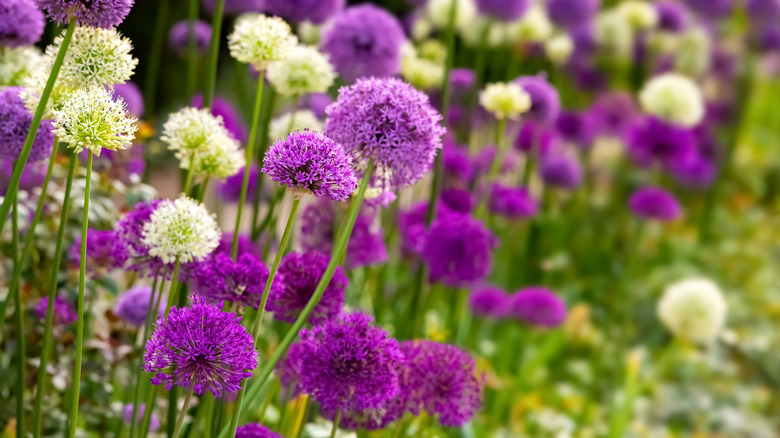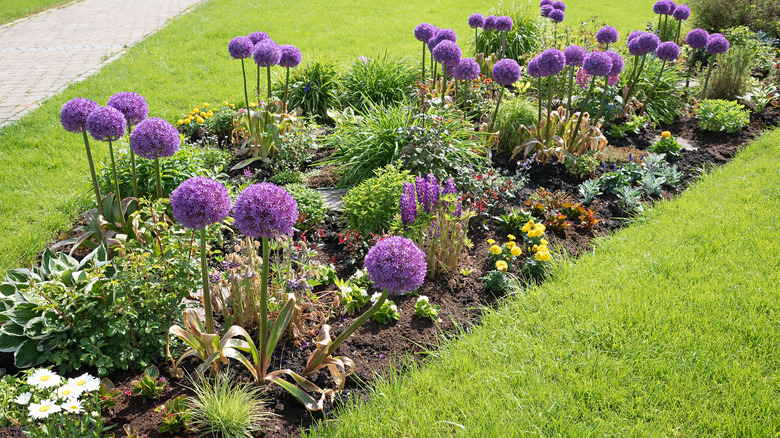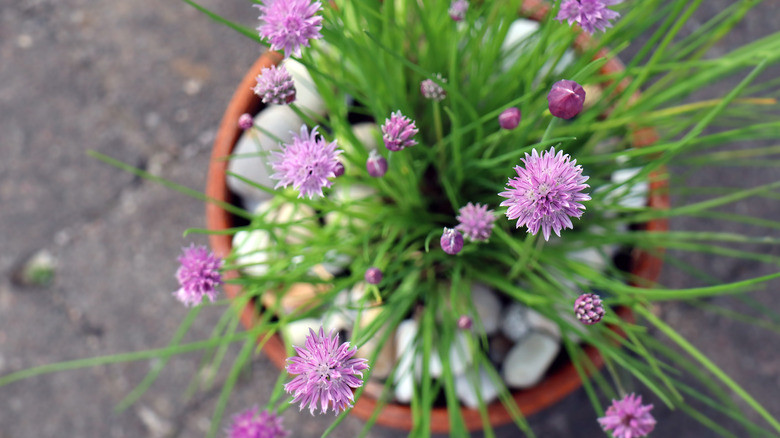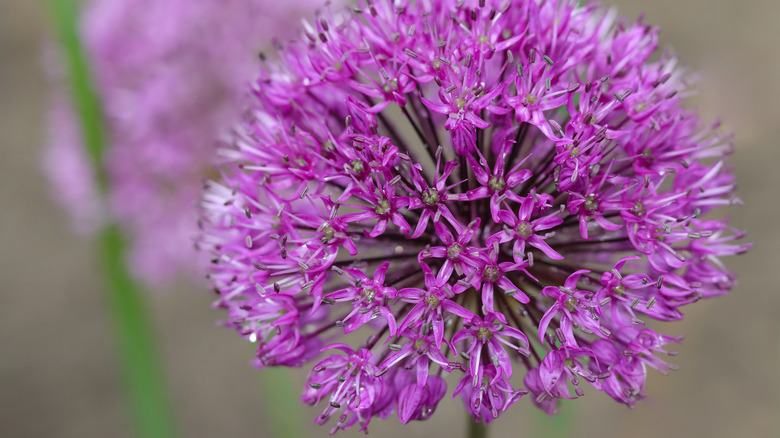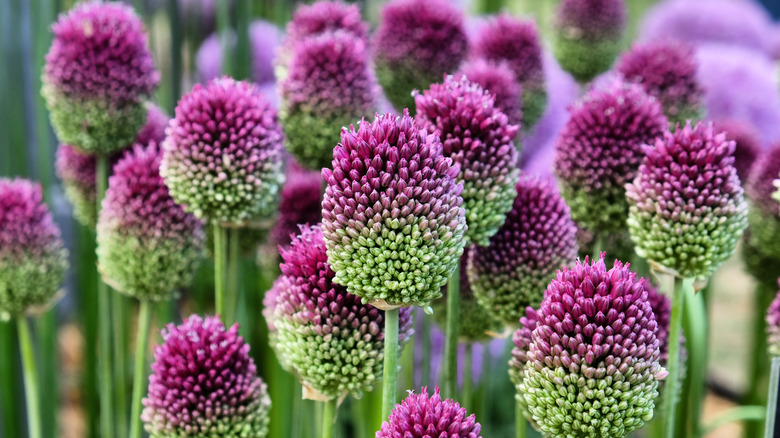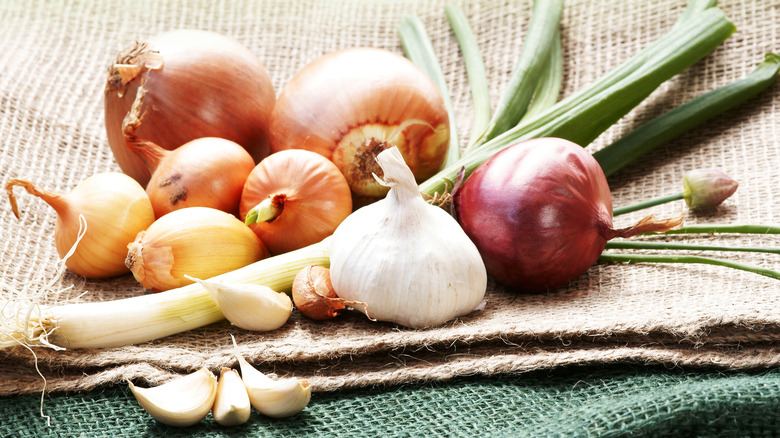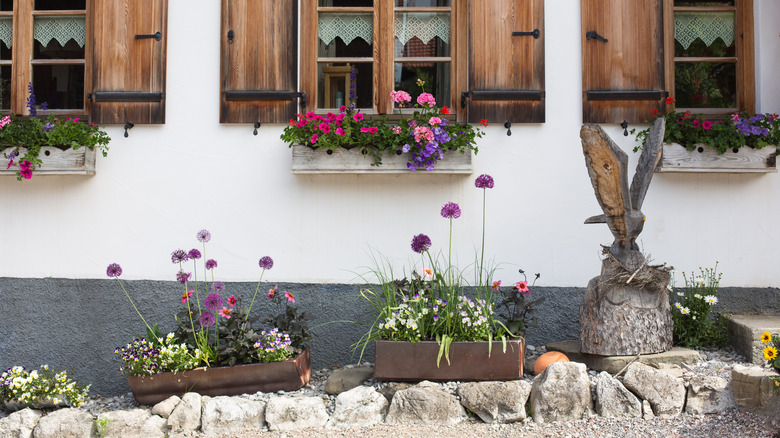How To Grow And Take Care Of An Allium Plant
Onions and garlic are a staple in many recipes, but what you might not know is that they come from the same type of plant, called allium plants. According to Gardener's Supply Company, there are over 700 varieties of these perennial flowering plants; some more known varieties include onions (allium cepa) or garlic (allium sativum). Many other types are simply ornamental, featuring stems that can grow several feet high and large round flower heads in various colors, including purple, yellow, and white.
Alliums rose to popularity in the late 1800s when Russian botanists began collecting them from Central America for their gardens. The British then caught on to the trend and started using alliums in their gardens. To this day, alliums are popular garden plants because they are easy to grow and feature bold flowers that stand out among the shorter foliage. As an added bonus, alliums attract bees and other pollinators and are resistant to typical garden pests like rodents and deer because of their odor, although you probably won't notice a smell unless you crush their leaves.
How to use alliums in garden
Longfield Gardens discussed that alliums are best planted with other perennials in your ornamental garden. Keep in mind that different varieties of alliums bloom at different times, and with such diversity in height and bloom type, it's important to plan your garden ahead of time. Alliums look best with other perennials that have lower foliage, such as lilies, daffodils, or tulips, allowing their large, bright flowers to really shine. Other examples of pairings with alliums are ornamental grasses, lavender, or peonies. When the flowers are blooming, alliums are an excellent accent flower for your garden, and even as they begin to fade, they add a wonderful texture to your garden.
Of course, you may also plant alliums in your vegetable garden for their practical uses. Chives, onions, and garlic may be planted simply to be used in recipes. You will still get those colorful flower heads that add some visual interest to your vegetable garden.
How to grow alliums
Alliums are a very easy perennial to grow, making them a great addition to your vegetable or ornamental garden. Alliums grow from bulbs, and Dutch Grown explained that it is best to plant allium bulbs in your garden during the autumn when the soil is around 60 degrees Fahrenheit. Alliums do well in most soil types, as long as there is proper drainage. To avoid the harsh conditions of changing temperatures, the bulbs need to be planted around 4 to 8 inches deep with the pointy part of the bulb sticking up. The bulbs should be 6 to 8 inches apart, so they have enough room to grow. Water the bulbs after they're planted, but then you can leave them alone until springtime, where they need occasional watering if there isn't rain.
You can also grow alliums in containers, and the process is very similar. Wait until the soil is around 60 degrees Fahrenheit, and prep your container with loose soil so water doesn't pool at the bottom. You want a container with proper drainage located in full sun. The allium bulbs get planted 4 to 8 inches deep and 6 to 8 inches apart, although if your container is smaller, they can be closer together, just not touching. Water the bulbs once they're planted, and if you live in a particularly cold climate, you can bring your container into your garage or another unheated indoor space for the winter.
How to care for alliums
You may have noticed that your chives grow without much attention, and before you know it, they are huge. That's because caring for alliums is super easy and very little work. These low maintenance plants need infrequent watering, usually taken care of by rainfall, and full direct sunlight to thrive, although some varieties can survive with partial sunlight. Since there are so many varieties of alliums, check the specific care instructions for your variety to ensure success. Alliums also require periodic weeding and fertilization, which can be taken care of by using weed block or adding organic mulch after planting the bulbs.
According to Gardening Know How you have a few options after alliums bloom. After the flowers finish their bloom, you can deadhead the blooms or leave them there for some added texture to your garden until the foliage fades, but leave the foliage until it fades so the plant can gather energy to bloom the following year. Additionally, every few years, when around 8-10 bulbs are formed, it's important to divide the bulbs by digging them up and separating them gently with your hands (much like a head of garlic). You can then plant the bulbs around your garden for more alliums the following year.
Allium varieties
There are over 700 varieties of allium plants, including onions (allium cepa), garlic (allium sativum), leeks (allium ampeloprasum), and chives (allium schoenoprasumand). Aside from these well-known allium varieties, there are tons of ornamental varieties that can add a sense of drama and design to your garden. With blooms ranging from a few inches to several feet tall, these plants can be naturally found all around North America. A few varieties discussed by Garden Therapy that you may plant in your garden include:
- Drumstick alliums (A. sphaerocephalon): This variety grows up to 2 feet high, and the drumstick-shaped bulbs change from green to purple as they bloom in late spring.
- Ivory queen (A. karataviense): Featuring purple-gray flowers and spotted leaves, the ivory queen gives off a pleasant scent and does well in container gardens.
- Nodding onions (A. cernuum): An edible variety of alliums, nodding onions droop and hang upside down after they bloom in summer.
- Globemaster (A. giganteum): A large variety of allium, these 4-foot-tall plants bloom an eight-inch diameter round head with over 100 flowers.
- Tumbleweed onion (A. shubertii): Resembling a firework, this sculptural plant grows over a foot tall and blooms in May or June.
Are alliums toxic?
Allium plants sound like a great addition to any garden, with eye-catching flowers, tall stems, and practical uses. Most allium varieties are edible to humans, including onions, garlic, leeks, and chives. Some types have bulbs that you eat, like onions, while some have tasty stalks, like chives.
For the same reason you shouldn't feed your dog or cat foods that contain onion or garlic; you shouldn't let them eat allium plants from your yard or garden either. Home Guides warned that all allium plants are poisonous to both dogs and cats, so it is not safe to plant alliums where your pets can get to them. If you come across these plants growing in the wild, it is also advised for humans to avoid eating them because wild versions of alliums can cause intestinal discomfort. Stick with ones you've grown on your own that are verified edible if you want to add them to foods.
How to repot alliums
If you have chosen to plant your alliums in a container or pot, you will have to eventually repot the plants once they grow too large for the container. It is best to repot your alliums in the autumn, in the same conditions as regular allium planting.
As explained by The Spruce, the first step of repotting is to dig around the plant in the original pot to pull out the bulbs. Depending on how old your allium plant is, you will find several bulbs. Split the bulbs by gently separating them with your hands. Next, prepare your new pot with well-draining soil and plant the bulbs 4 to 8 inches deep and 6 to 8 inches apart if possible, but they can be closer if needed. If you have extra bulbs that don't fit in your new pot, plant them around your garden for some added height and color. Lastly, water the bulbs, and by the following year, you will have new alliums in your containers.
